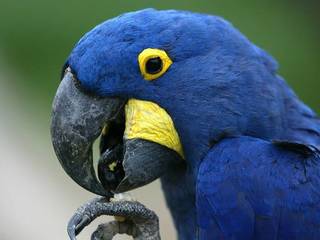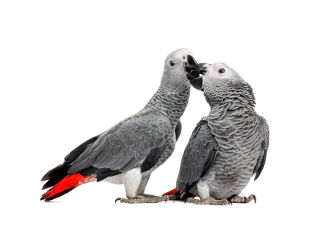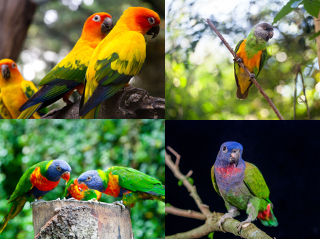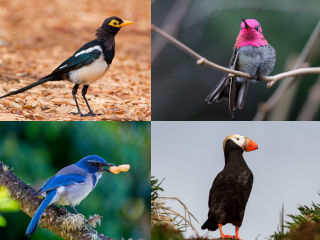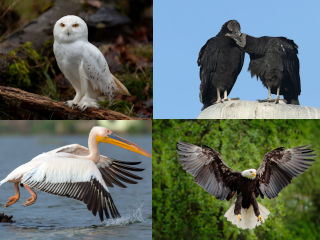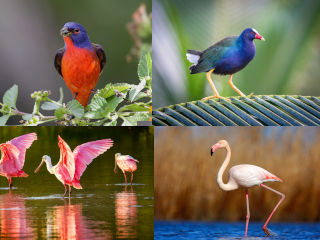Birds of prey, also known as raptors, are a fascinating group of birds known for their sharp talons, keen eyesight, and predatory nature. These birds come in a variety of shapes and sizes, and while some species are known for their agility and speed, others are renowned for their voracious appetites.
Birds of prey with big appetites are particularly fascinating, as they are able to consume a wide variety of prey ranging from small rodents and insects to larger mammals and even other birds. In this article, we will take a closer look at some of the most impressive birds of prey with big appetites and explore what makes them such successful predators.
1. California Condor
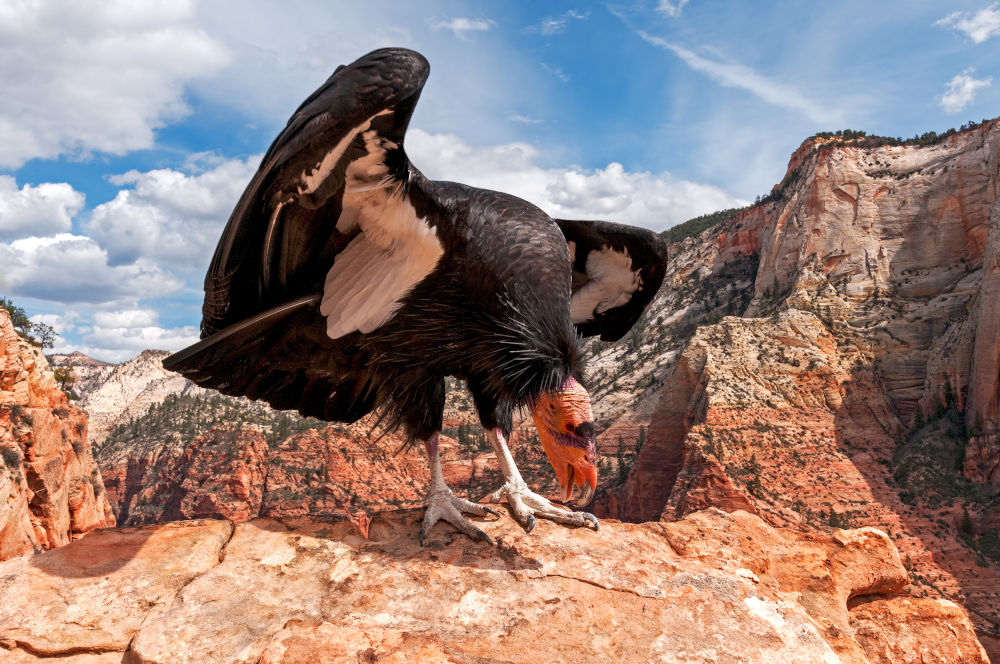
The California condor is a large vulture species found in North America. They have a unique appearance with their black feathers, white patches on their wings, and bald heads. Their wingspan can reach up to 9.5 feet and they can weigh up to 26 pounds.
The California condor is a scavenger and primarily feeds on the carcasses of large mammals such as deer and cattle. They have an acute sense of smell that allows them to locate their food from great distances.
Due to habitat loss, hunting, and poisoning, the California condor's range has significantly decreased, and today, there are only about 500 individuals left in the western United States.
The California condor is one of the most endangered bird species in the world, and conservation efforts have been put in place to save them. In 1987, only 27 individuals remained in the wild, and a captive breeding program was initiated to increase their population.
Today, there are around 500 individuals, with about half living in the wild and the other half in captivity. The main threats to their survival include habitat loss, lead poisoning from contaminated carrion, and collisions with power lines. Conservation efforts have been focused on reducing these threats, including providing safe food sources, replacing lead ammunition with non-toxic alternatives, and installing power line markers to reduce collisions.
The California condor plays an important role in their ecosystem by cleaning up carrion and helping to prevent the spread of disease. They are also a significant cultural icon for many Native American tribes who consider them to be symbolic animals. Overall, the California Condor is a fascinating and important species that requires ongoing conservation efforts to ensure its survival in the wild.
2. Golden Eagle
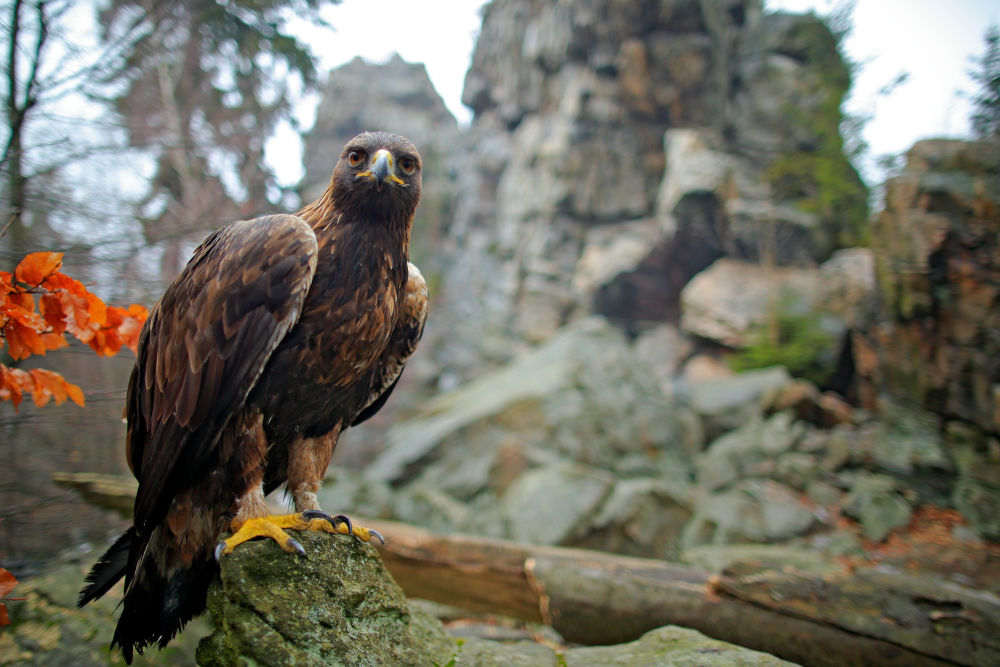
The Golden Eagle is a majestic bird of prey that belongs to the family Accipitridae. It is one of the largest eagles in the world, with a wingspan of up to 7 feet and a weight of up to 15 pounds. Golden Eagles are found in many parts of the world, including North America, Europe, Asia, and North Africa.
Golden Eagles are found in a variety of habitats, including mountains, deserts, and forests. They prefer open areas with few trees, such as grasslands, tundra, and alpine meadows. Golden Eagles are also found in urban areas, where they often nest on tall buildings or other structures.
Golden Eagles are solitary birds that mate for life. They are powerful fliers and can soar for hours without flapping their wings. They use their keen eyesight to locate prey from a distance of several miles away. Once they spot their prey, they swoop down and capture it with their sharp talons. Golden Eagles are also known for their impressive hunting skills, and they can take down prey much larger than themselves, including deer, coyotes, and even young bears.
Golden Eagles are carnivorous and primarily feed on small mammals, such as rabbits, squirrels, and marmots. They also prey on birds, including grouse, pheasants, and ducks. Golden Eagles are opportunistic hunters and will sometimes scavenge on carrion or steal food from other predators.
3. Gyrfalcon
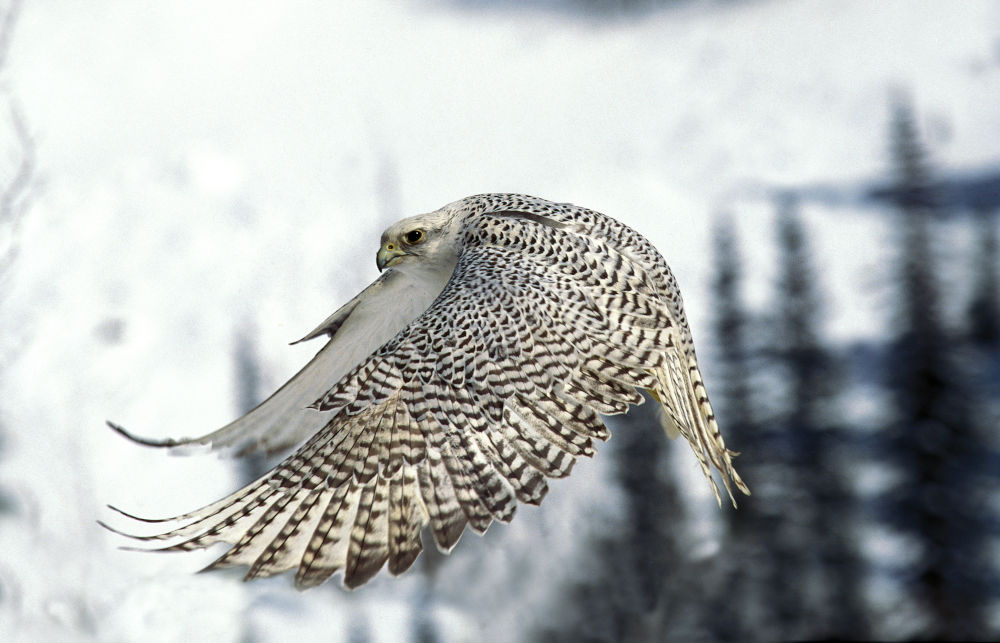
The Gyrfalcon is a large bird of prey belonging to the family Falconidae. It is one of the largest species of falcons and is found throughout the circumpolar regions of the northern hemisphere, including Arctic and subarctic regions of North America, Europe, and Asia.
The gyrfalcon is a highly specialized predator, and it is known for its incredible speed and agility. It feeds primarily on other birds, such as ptarmigans, grouse, and waterfowl, but it also preys on small mammals like lemmings and rabbits.
The gyrfalcon is a powerful and majestic bird, with a wingspan that can reach up to 63 inches and a weight of up to 3.5 pounds. It has a distinctive white plumage with black stripes and spots, although some individuals have darker plumage.
Gyrfalcons are known for their impressive hunting skills and are highly valued by falconers. They are also considered a species of least concern by the International Union for Conservation of Nature (IUCN), although populations in some areas may be threatened by habitat loss, hunting, and other factors.
4. Ferruginous Hawk
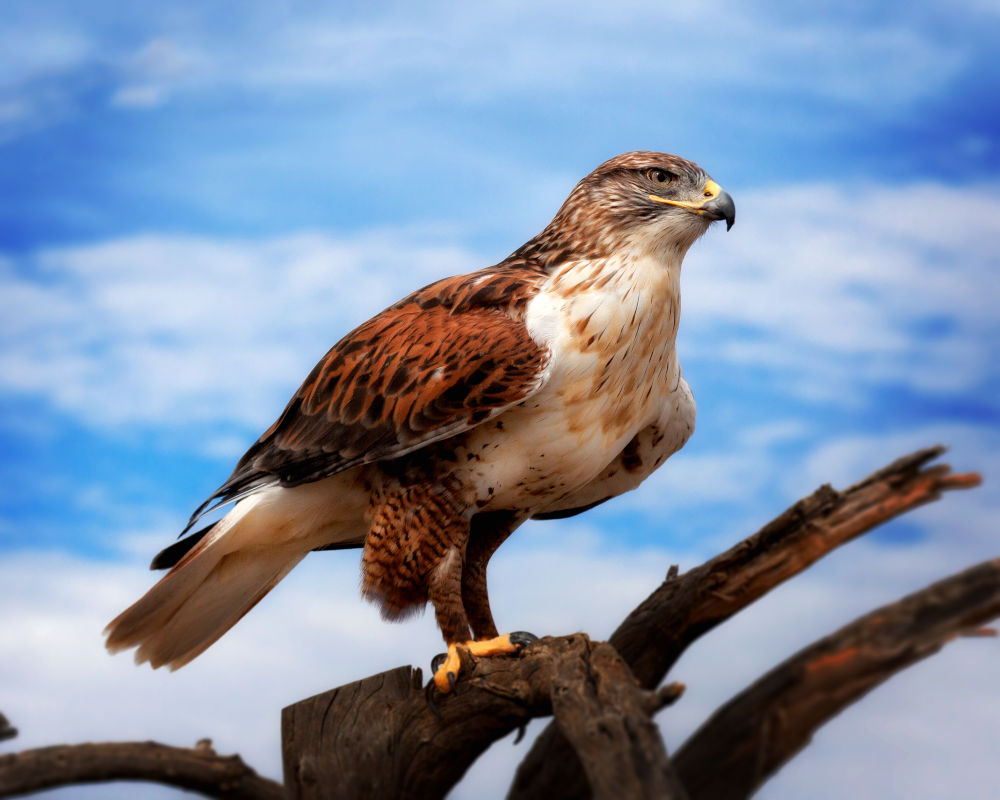
The Ferruginous Hawk is a large bird of prey found in the western regions of North America, from southern Canada down to Mexico. It is the largest hawk found in North America, with a wingspan of up to 4 feet and a length of up to 2 feet.
The Ferruginous Hawk gets its name from the rusty-red coloration of its legs and feathering on its back. The rest of its body is a pale buff color with white underparts, and it has a distinctive dark belly band. Juvenile birds have more mottled plumage and lack the belly band.
Ferruginous Hawks are birds of open country, including grasslands, deserts, and shrublands. They hunt from perches or by soaring over the ground, and their prey consists mainly of small mammals such as ground squirrels, rabbits, and prairie dogs, as well as birds and reptiles.
Ferruginous Hawks mate for life, and pairs will return to the same nesting site year after year. They build their nests on cliffs, trees, or man-made structures such as telephone poles or wind turbines. The female lays 2-4 eggs, which both parents will incubate for about a month. The chicks fledge at around 6-7 weeks old and will stay with their parents for several months.
Ferruginous Hawks are considered a species of conservation concern due to habitat loss and fragmentation, as well as persecution by humans. Efforts are underway to conserve and protect their habitat and populations.
5. Turkey Vulture
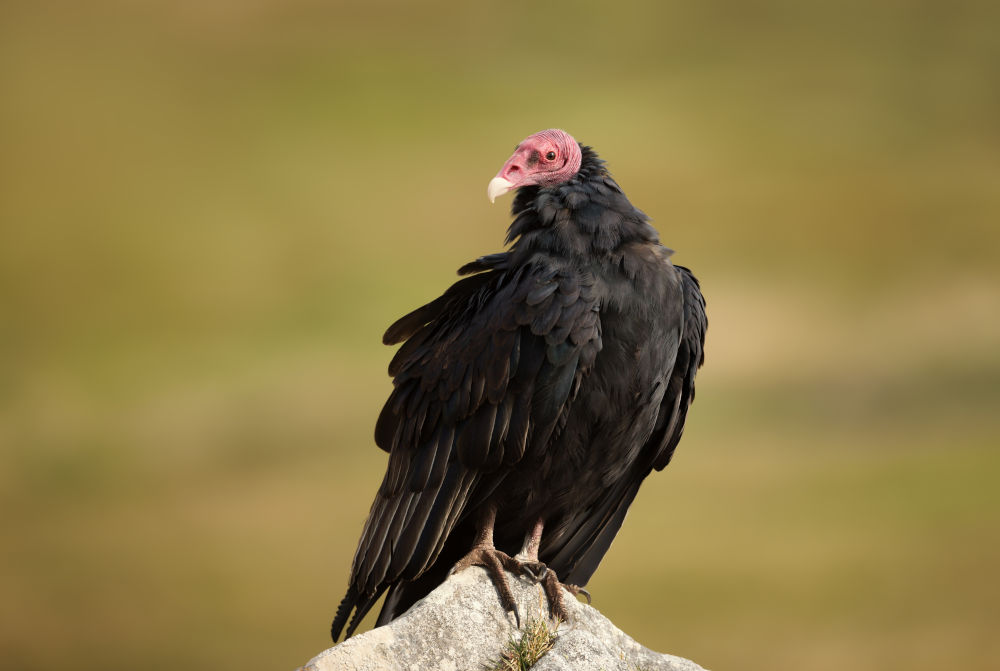
The Turkey Vulture is a large bird of prey found in North and South America. These birds have a wingspan of up to 6 feet and are known for their dark brown to black feathers and featherless, reddish head.
Turkey Vultures are scavengers and primarily feed on carrion. They have a keen sense of smell that helps them locate carrion from great distances.Turkey Vultures are scavengers and feed primarily on carrion, or dead animals. When they locate carrion, they will land near it and use their sharp beak to tear open the flesh. Unlike many other birds of prey, Turkey Vultures do not kill their prey. They are able to locate carrion from great distances, thanks to their keen sense of smell. In fact, their sense of smell is so strong that they can detect the gasses produced by the early stages of decomposition, which allows them to locate carrion that is hidden from sight. Once they have torn open the flesh, they will use their long, thin tongue to lap up the meat and other soft tissue.
They are often seen soaring high in the sky on thermals, with their wings held in a dihedral (V) shape. Turkey Vultures roost in trees or on the ground in large groups and are sometimes seen sunbathing with their wings spread open.
Turkey Vultures form monogamous pairs that mate for life. They build their nests on the ground, in caves, or in hollow trees. Female Turkey Vultures lay 1-3 eggs, which hatch after about a month. Both parents share the task of incubating the eggs and feeding the chicks. Chicks fledge after 2-3 months.
Although Turkey Vultures are not considered threatened, habitat loss, hunting, and poisoning from pesticides and lead ammunition can pose a threat to their populations. These birds play an important role in the ecosystem as scavengers, helping to keep the environment clean by consuming carrion that could otherwise spread disease.
6. Bald Eagle

The bald eagle is a bird of prey found in North America, and is the national bird and symbol of the United States. It has a distinctive white head, brown body, and yellow beak and feet. The bald eagle's scientific name, Haliaeetus leucocephalus, means "white-headed sea eagle".
Bald eagles are primarily fish-eaters and are often found near water bodies such as lakes, rivers, and coastal areas. They also feed on small mammals, birds, and carrion. Bald eagles are powerful hunters and can fly at speeds of up to 40 miles per hour (64 km/h).
Bald eagles mate for life and build large nests in tall trees or on cliffs. They use the same nest each year, adding to it as necessary. Nests can be up to 13 feet deep and 8 feet wide, and can weigh up to 1 ton.Bald eagles were once endangered due to hunting, habitat loss, and pollution. However, their populations have since recovered thanks to conservation efforts, and they were removed from the endangered species list in 2007.
In addition to being the national bird of the United States, the bald eagle is also a symbol of strength and freedom.
7. White Pelican
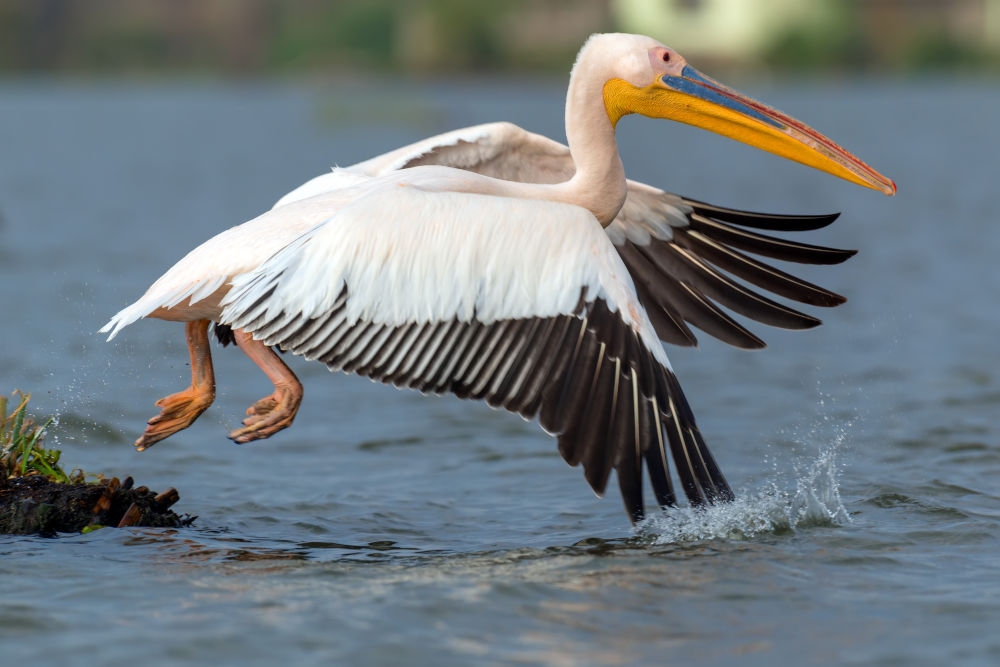
The white pelican is a large aquatic bird native to North America. It is a bit different from other birds on this list but certainly worth mentioning because of its appetite! The White Pelican isn’t a typical raptor with a hooked nose and sharp claws to use to kill their prey.
Instead, the white pelican uses its powerful beak. It is mostly white with black primary feathers visible when in flight, a long, flat, yellow-orange bill, and a distinctive pouch that hangs from its lower bill.
During the breeding season, they develop a prominent knob on their bill. White pelicans are found near shallow, freshwater lakes, rivers, and marshes in western and central North America. They tend to prefer quiet, secluded areas with minimal human disturbance.
These birds are primarily fish-eaters and will plunge-dive from the air to catch their prey, although they also eat crustaceans and amphibians. White pelicans are social birds that often gather in large flocks and are known for their impressive aerial displays, in which they fly in synchronized patterns.
They breed in colonies, with pairs forming within the larger group, and typically lay two eggs, with both parents sharing incubation duties. While the white pelican is considered a species of least concern by the International Union for Conservation of Nature (IUCN), populations in some areas have declined due to habitat loss, human disturbance, and pollution.
White pelicans primarily feed on fish, and they are highly specialized for this type of diet. They use their large, flat bills to scoop up fish from the water's surface, and they can hold up to 3 gallons of water in their pouches, which they use to drain the water and swallow the fish. They also eat crustaceans and amphibians.
White pelicans breed in colonies, with pairs forming within the larger group. They typically nest on isolated islands or marshy areas that are free from predators. The nest is usually a shallow depression in the ground, lined with vegetation and other materials.
Both parents share incubation duties, with each taking turns sitting on the eggs while the other feeds. Once the eggs hatch, both parents continue to care for the chicks, bringing them fish and other prey. The young pelicans fledge at around 10 weeks old and are able to fly shortly after.
8. American Kestrel
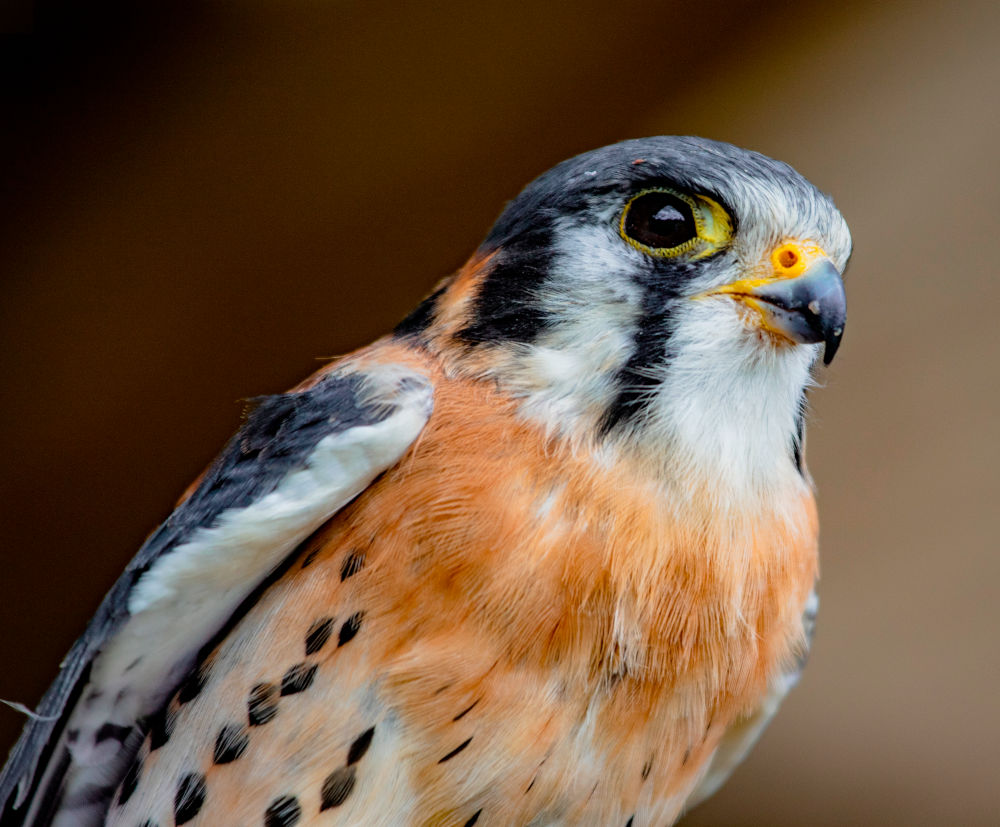
The American Kestrel is a small bird of prey that is widely distributed throughout North and South America. These birds are known for their striking plumage, which includes a rust-colored back, blue-gray wings, and a white and black head. American Kestrels are sexually dimorphic, with males having more brightly colored plumage than females.
These raptors are often found in open habitats such as grasslands, deserts, and agricultural areas, where they hunt small prey such as insects, small mammals, and reptiles. They are capable of hovering in mid-air to spot their prey and then swooping down to catch it with their sharp talons. Despite their small size, American Kestrels are fierce hunters and have been known to take down prey that is several times their own weight.
American Kestrels are also known for their vocalizations, which include a series of loud, rapid, and repetitive calls. These calls are used for communication between mates and to defend their territory against intruders.
American Kestrels are opportunistic hunters and their diet varies depending on the availability of prey in their habitat. They primarily feed on small mammals such as mice, voles, and shrews, but they also hunt insects, reptiles, and occasionally birds. Kestrels are known for their ability to hover in mid-air to scan the ground for prey, and they use their sharp talons to catch their food.
During the breeding season, which typically occurs from March to August, American Kestrels form pairs and build nests in cavities such as tree hollows, crevices in cliffs, and old buildings. Sometimes, American Kestrels will even utilize nesting boxes provided by humans. The female lays a clutch of 3-7 eggs, which are incubated by both parents for about a month. After hatching, the chicks are fed by both parents until they fledge at around 4 weeks of age.
American Kestrels are known for their adaptability, and they are able to nest in a variety of habitats, from open fields to urban areas. However, habitat loss and fragmentation can pose a threat to their nesting success, as suitable cavities for nesting may become scarce. Conservation efforts such as providing nest boxes can help to support kestrel populations, and promoting habitat conservation can ensure that they have the resources they need to thrive.
9. Snowy Owl

Snowy owls, also known as the Arctic owl, are magnificent birds that inhabit the Arctic regions of North America and Eurasia. They are the largest species of owl by weight, weighing about 4 pounds. Their wingspan can reach up to 49 to 57 inches, making them one of the most impressive birds of prey in the world.
Snowy owls have a distinctive appearance with their pure white feathers that help them blend in with their snowy surroundings. Their beaks and claws are black, and they have yellow eyes.
In addition, they have a unique adaptation in their feathers that enables them to remain warm in their cold habitat. Their feathers have an insulating layer of down underneath the outer layer, which allows them to maintain their body temperature even in the harshest of conditions.
Snowy owls are found throughout the Arctic tundra and are known for their ability to adapt to extremely cold environments. During the winter months, they are often found in southern Canada, the northern United States, and sometimes even as far south as the Great Lakes region. However, during the summer months, they return to their breeding grounds in the Arctic tundra.
Snowy owls are primarily solitary birds and are active during the day and night. They are skilled hunters and have a diverse diet that includes small mammals, birds, and fish. They are also known to take advantage of food sources such as lemmings, voles, and other small rodents, which are abundant in their Arctic habitat. They have a keen sense of hearing and vision, which allows them to locate prey even in the darkness of the Arctic night.
Snowy owls typically breed during the summer months and will return to their breeding grounds in the Arctic tundra to mate and nest. Females lay between 3 to 11 eggs, which are incubated for approximately 32 days. The male will provide food for the female during this time. Once the eggs hatch, the female will take care of the young while the male continues to hunt for food.
10. Black Vultures
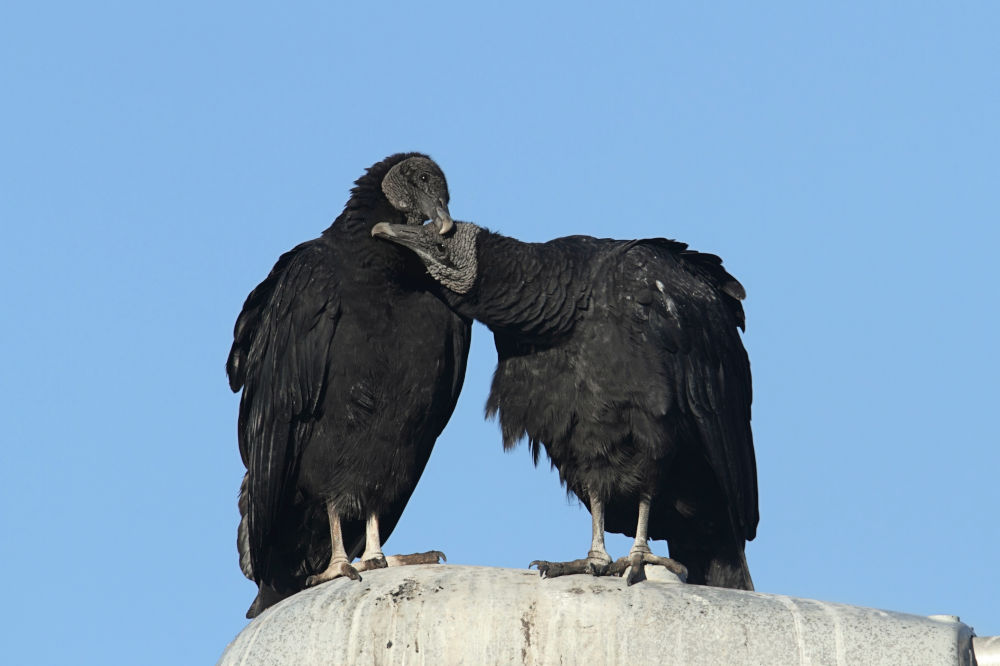
Black vultures are a species of bird native to the Americas. They are known for their distinctive black plumage and their role in cleaning up carrion, or the remains of dead animals.
Black vultures are social birds that are often seen in groups, known as kettles, soaring in the skies above. They have a wingspan of up to six feet and can weigh up to five pounds.
They are predominantly black in color, with a bare, wrinkled head that is often described as looking like a black featherless turkey's head. Their beaks are short and hooked, and their eyes are large and brown.
Black vultures are opportunistic feeders and will eat a wide range of carrion, including mammals, birds, reptiles, and fish. They are often seen feeding on roadkill and other dead animals along the sides of roads. They also eat the afterbirth of cattle and other domesticated animals.
Black vultures are known to exhibit a behavior called "urohydrosis," which involves urinating on their legs to cool down in hot weather. They also use their large, powerful wings to thermoregulate, or regulate their body temperature, by flying high into the air to cool down or lower in altitude to warm up.
Black vultures are found throughout the Americas, from the southern United States to South America. They prefer open habitats such as savannas, grasslands, and deserts. They are also found in urban and suburban areas, where they can scavenge on roadkill and other human-produced waste.
Conclusion
In conclusion, birds of prey with big appetites are fascinating creatures that play an essential role in maintaining the ecological balance of their respective habitats. From the powerful peregrine falcon to the majestic bald eagle, these birds have evolved to hunt and consume large prey, demonstrating their impressive physical abilities and impressive hunting strategies.
FAQ
Why are birds of prey important?
Birds of prey, also known as raptors, are important for several reasons: Ecological Balance: Birds of prey play a critical role in the ecosystem by controlling the populations of other animals. They are at the top of the food chain, and their presence helps to keep populations of smaller animals in check. Pest Control: Many birds of prey feed on rodents, which can be major agricultural pests. By controlling rodent populations, birds of prey can help to reduce crop damage and disease transmission. Indicator Species: Birds of prey are often used as indicators of ecosystem health, as they are sensitive to changes in their environment. Declines in raptor populations can be an early warning sign of environmental problems, such as pollution or habitat loss. Cultural Importance: Birds of prey are often symbols of power and strength in many cultures. They are also important in many traditional hunting and falconry practices. Scientific Research: Birds of prey are often studied by scientists to better understand their behavior, biology, and ecology. This research can help inform conservation efforts and can lead to new discoveries in many fields of science.
When prey becomes predator?
In some cases, when prey populations become too large or when predators are scarce, some prey species can exhibit predatory behavior. This phenomenon is known as "prey switching" or "prey-predator reversal". Here are a few examples: Mantis Shrimps: Mantis shrimps are typically predators, but some species have been known to eat small fish or other mantis shrimps. Frogs: Some species of frogs, such as the ornate horned frog, are known to eat small mammals and other frogs. Birds: Some bird species, such as the peregrine falcon, are apex predators that feed on other birds. However, some bird species have been known to feed on small mammals, reptiles, or even other birds. Snakes: Snakes are typically predators, but some species have been known to eat other snakes, including members of their own species.
Do birds prey on cats?
While it is not common for birds to prey on cats, there have been some documented cases of birds attacking cats. This usually occurs when the bird perceives the cat as a threat or is protecting its young or territory. For example, large birds of prey such as eagles, hawks, and owls have been known to attack and kill small cats, especially kittens, if they perceive them as potential prey. Additionally, some smaller birds, such as crows or mockingbirds, may dive-bomb or harass cats if they feel threatened by them or if they perceive them as a threat to their nests or young.
Do birds prey on small dogs?
While it is not common for birds to prey on small dogs, there have been some documented cases of birds attacking small dogs. This usually occurs when the bird perceives the dog as a threat or is protecting its young or territory. Large birds of prey such as eagles, hawks, and owls have been known to attack and kill small dogs, especially toy breeds or puppies, if they perceive them as potential prey. Additionally, some smaller birds, such as crows or magpies, may dive-bomb or harass dogs if they feel threatened by them or if they perceive them as a threat to their nests or young.

